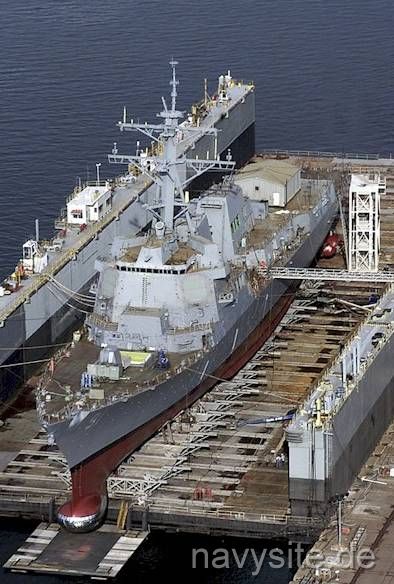#59
Mensagem
por JLRC » Qua Jan 11, 2006 2:43 pm
Sea-Based X-Band Radar Arrives at Pearl Harbor
(Source: US Missile Defense Agency; issued Jan. 10, 2006)
Air Force Lieutenant General Henry “Trey” Obering, Missile Defense Agency Director, announced that the Sea-Based X-Band Radar (SBX) arrived in Hawaii today after its 15,000 mile trip from Texas.
The SBX made the trip from Corpus Christi, Texas aboard the MV Blue Marlin, a semi-submersible heavy lift vessel. Although the SBX is self-propelled, it rode aboard the Blue Marlin in order to save time on the trip and to avoid wear and tear on the vessel. Later this week the SBX will be offloaded from the heavy lift vessel and will begin minor modifications, post-transit maintenance and routine inspections before completing its voyage to its home port of Adak, Alaska. Offloading and berthing operations are expected to take several days and during that time a safety perimeter will be maintained by the U.S. Coast Guard.
The SBX is compliant with existing national and state environmental regulations and laws and will pose no threat to people or wildlife in Hawaii. It has completed many major milestones in its development, the two most recent being tracking satellites and completing sea trials. Early on Oct. 12, 2005, the radar aboard the SBX successfully tracked several orbiting satellites over a three-hour period. The radar acquired each object and maintained tracks for several minutes, demonstrating this key functionality for the first time. Achieving this milestone demonstrates the radar software is able to control thousands of individual transmit and receive modules.
The SBX stands more than 280 feet tall and displaces more than 50,000 tons. It consists of a semi-submersible oil production platform, topped with an X-band radar array.
Although it will be home-ported in Alaska, the SBX will be capable of moving throughout the Pacific Ocean to support both advanced missile defense testing as well as defensive operations. The SBX will provide missile tracking, discrimination and hit assessment functions to the Ground-based Midcourse Defense (GMD) element of the Ballistic Missile Defense System.
It will support interceptor missiles located in Alaska and California if required to defend against a limited long-range missile attack on the United States. Over time, the SBX will be able to support defense from missiles that may be used against our homeland, deployed forces, allies and friends. (ends)
Boeing Sea-Based X-Band Radar Completes Transport through the Straits of Magellan and Arrives in Pearl Harbor
(Source: Boeing Co.; issued Jan. 10, 2006)
ST. LOUIS --- Boeing announced today the arrival in Hawaii of the Sea-Based X-Band Radar (SBX) built for the U.S. Missile Defense Agency. This marks an interim stop in the vessel's transport operation, originating in the Gulf of Mexico and maneuvering through the Straits of Magellan, ultimately destined for Adak, Alaska.
A major sensor for the Missile Defense Agency's ground-based midcourse defense program (GMD), the SBX will provide the capability to track ballistic missiles and their warheads, discriminate among various objects in flight, and provide data for intercepting targets and their destruction. The addition of the SBX to MDA's missile defense system is another key milestone toward the evolution of a layered and integrated Ballistic Missile Defense System (BMDS).
"The arrival of SBX in the Pacific builds on the momentum of the GMD program, which recently conducted a successful flight test and installed its 10th operational interceptor missile at Fort Greely," said Pat Shanahan, Boeing Missile Defense Systems vice president and general manager. "The SBX is a one-of-a-kind platform that will perform essential sensing functions for the Ballistic Missile Defense System. It can be deployed worldwide; it can sense small objects thousands of miles away; it can provide critical data on incoming ballistic missile threats; and it is the only platform of its type in the world. No other platform within the BMDS provides all these attributes."
Prior to its departure on its journey around South America through the Straits of Magellan, integration, assembly and test of the radar and platform were conducted at Corpus Christi, Texas. Following a series of sea trials, the SBX was transported into the Pacific Ocean aboard a commercial heavy transport vessel, the motor vessel Blue Marlin, which is owned and operated by Dockwise Shipping B.V. of Breda, The Netherlands.
The radar will join other land and sea-based radars and space-based sensors, to support the overall ballistic missile defense capability, with initial integration into the command, control, communication and battle management system for the long-range interceptor missiles located in Alaska and California, improving their ability to defend against a limited long-range ballistic missile attack on the United States. Home-ported in Adak, a small island located in the Aleutian Island chain, the SBX will be able to move throughout the Pacific Ocean, or any of the world's oceans, in support of advanced missile defense testing and defensive operations.
The SBX program team completed important milestones despite challenges throughout last year's intensive hurricane season. During scheduled program operations, the radar tracked orbiting satellites, which demonstrated key functionality. The program completed more than 100 test activities, demonstrating its ability to achieve major sustainment and operational capabilities, including: transferring personnel, supplies and fuel, performing at-sea maintenance and the ability to operate at sea for extended periods.
Boeing is the prime contractor for the GMD program. Industry partners include: Raytheon, who manufactured the X-band radar; Kiewet OffShore Services where the radar was constructed and integrated onto the SBX; Moss Maritime, who supplied the platform; Keppel-AmFELS, who modified the platform with Boeing; and Vertex/RSI, who worked on the radar structure.
A unit of The Boeing Company, Boeing Integrated Defense Systems is one of the world's largest space and defense businesses. Headquartered in St. Louis, Boeing Integrated Defense Systems is a $30.5 billion business. It provides network-centric system solutions to its global military, government, and commercial customers. It is a leading provider of intelligence, surveillance and reconnaissance systems; the world's largest military aircraft manufacturer; the world's largest satellite manufacturer and a leading provider of space-based communications; the primary systems integrator for U.S. missile defense; NASA's largest contractor; and a global leader in sustainment solutions and launch services.
-ends-














